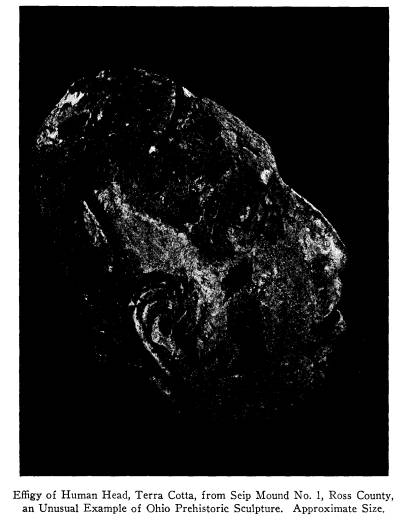Ohio History Journal
A HOPEWELL SCULPTURED HEAD
By RICHARD G. MORGAN
During the excavation of Seip Mound No.
1, Ross County.
Ohio, in 1927, a sculptured human head
was found.1 It was in
a fragmentary condition due partly to
its having been subjected
to fire and partly to an accident in its
removal; hence an adequate
description was not possible at the time
the report was written.
The specimen has now been restored from
dozens of small frag-
ments and due to its unique character it
has been considered
worthy of a complete published
description.
The restoration is accurate as most of
the pieces make exact
contact with one another. It should be
noted, however, that the
position of the ears had to be
approximated as their points of
contact were missing. In addition, the
pupil of the left eye was
completely reconstructed as was the
nose. The width of the nose
was indicated at the root and at the
nostrils but its contour is
hypothetical.
The head was modeled from an un-tempered
clay and fired.
It is indicative of exceptional skill on
the part of the craftsman.
The ears, from all appearances, were
fashioned separately and
attached to the head before firing, and
the same may have been
true for other portions of the object.
The specimen is 81mm. in
height, 65mm. in width above the ears,
and 53mm. in width from
the point of the chin to the back of the
head at the base. The
surface is black in color on the right
side, back, and top, and is
a light buff to a mottled brown on the
left side. Traces of red
pigment are present on the ears, lips
and bottom of the object.
Fine lines caused by the modeling tools
may be seen at various
places on the surface.
The base of the object is broad, the
back is flattened from
side to side, and there is a decided
tapering of the head toward
1 H. C. Shetrone and E. F. Greenman,
"Explorations of the Seip Group of
Prehistoric Earthworks," Ohio State
Archaeological and Historical Quarterly, XL
(1931), 426.
(384)
